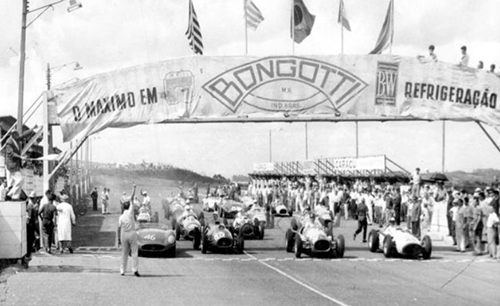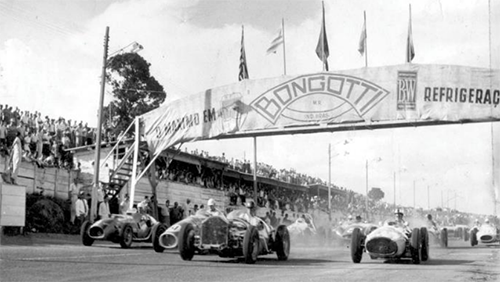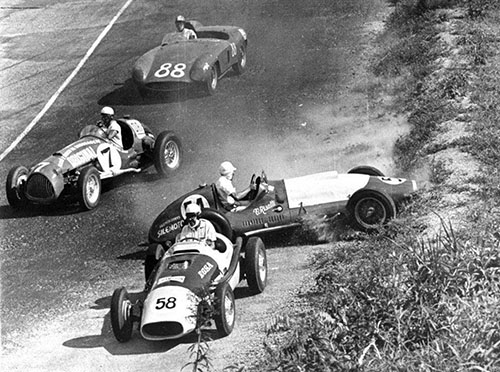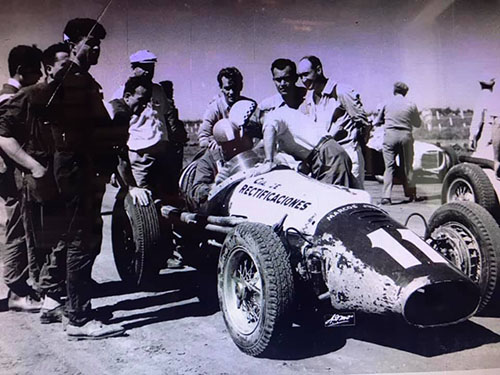The 1958-'61 South American Triangular Tournaments
- Where front-engined Formula One went to die
Part 4: Third edition of the South American Triangular Championship (1961)
Author
- Lorenzo Baer
Date
- August 14, 2024
Related articles
- The 1958-'61 South American Triangular Tournaments - Where the front-engined F1 went to die, by Lorenzo Baer
- 1934-'37 Rio GPs - Postcards from Gavea, by Mario Cesar de Freitas Levy/Leif Snellman/Antonio Carlos Barque de Lima
- 1949 Brazilian Temporada - Brazil's forgotten racing days, by Lorenzo Baer
- 1950 Chilean GP - The first, the last and the only, by Lorenzo Baer
- 1966 Argentinian F3 Temporada - It's never too late to revive old passions, by Lorenzo Baer
- 1967 Argentinian F3 Temporada - Time to go south again!, by Lorenzo Baer
- 1968 Argentinian F2 Temporada - The quick dash of the Cavallino Rampante in the Argentinian Pampas, by Lorenzo Baer
Why?
Race 1: I Etapa do Torneio Sul-Americano (Mecânica Nacional & Esporte Internacional)
Once again, the Triangular tournament returned to Interlagos to make its debut. But this seemed to be the only similarity with the race that marked the opening of the 1960 South American motorsport season, with major changes shaking the championship's organizing association. 1961 would be the year of uncertainty, and would ultimately, put an end to the ephemeral, but intense history of the Triangular.
The first big change could be seen in the cars and drivers. As mentioned in the previous chapter, José Froilán González had decided to retire definitively, leaving a big vacuum in the Triangular. It was undeniable that the former F1 driver and two-time Triangular champion was a charismatic figure within the South American circuit and that his presence was a great attraction for the championship's international events (and also, its commercial goals). Another popular Argentinian driver, Jesús Iglesias, had also begun to reduce his racing commitments, focusing more on his off-track business.
In Uruguay, there were changes as well, such as with the experienced Alberto Uria who gave up his place in the main AUVO team. These facts began to alarm the members of the ACB who saw a weakening of their neighbours in the Mecânica Nacional. Even so, the Brazilian association went ahead with the organisation of the third edition of the Triangular, trusting in the upward curve that the Brazilian drivers and teams had shown in the final stretch of 1960, within its national boundaries.
This was mainly due to the improvement in the mechanical potential of the Brazilian teams, especially after the Maseratis 250F began to perform as expected. For example, in addition to victory in the opening of the 1960 Triangular, Ciro Cayres had added three other triumphs in the same year driving the Italian machine: in the GP Cidade do Rio de Janeiro, in the GP Juscelino Kubitschek and in the I Circuito Internacional da Guanabara. Antônio Mendes de Barros had also achieved good results in Maserati #2531, while Margarido had suffered a serious accident driving #2507. The damage to the car was so extensive that #2531 was sent to the workshops for an indefinite period of time.
But it wouldn't take long for this decrease in Maseratis to be resolved, as the number was re-established at three 250Fs by the end of 1960. This was due to the import of Maserati #2532, brought from Italy by the Italo-Brazilian Ruggero Peruzzo. And this contingent was joined by a fourth Maserati car, #2530, which was purchased by the Italian resident in Rio de Janeiro Antonio Versa, from Spaniard Antonio Creus. However, despite the car being in Brazil between 1960 and 1961, it's known that this vehicle took part in just one race in Brazil, at the end of 1960 (to never being registered for any race after that).
Even so, the three Maseratis in racing conditions that the Brazilians had at their disposal at the beginning of 1961 represented the great force in the macro environment of South American motorsport at that precise period. In addition to these three vehicles came the traditional mix of several older cars which changed hands every year.
However, it was not only changes in the level of drivers and teams that impacted the 1961 Triangular. Aiming for strong expansion within the three Latin markets that made up the championship, the race organisation decided to allow the delegations of each country to be expanded for four drivers, adding one more driver to the regular composition of three that had been applied until now. This, it was thought, would be a way of creating a more solid and plurinational aspect of the endeavour, while it appeared as a simple solution to compensate for the departures of some of the better-known names in the championship – in other words, it was about replacing quality with quantity.
The real test of these new modifications was scheduled to take place on January 15th, on Brazilian soil. An impressive entry list of 30 drivers was released to the press days before the race in Interlagos, with three categories being admitted to the main race, valid for the Triangular: sportscars, MN/Fuerza Limitada cars (up to 2500cc) and MN/Fuerza Libre cars (over 2500cc). So, with such relaxed regulations, it is not surprising that a profusion of vehicles converged on the very traditional Brazilian circuit.


Two shots of the start of the 1961 Interlagos Triangular race. (Credits Luik Racing)
Regarding the teams selected to defend the colours of their respective countries, some changes occurred as well. For example, before the arrival of the AUVO and ACA delegations, scheduled to take place on January 12th, it was already known which drivers would represent the Uruguayans and Argentinians in the race. On the Colorado side, the four drivers highlighted were known figures from the Triangular: Alberico Passadore (Ferrari 166-212/Corvette), Carlos Danvilla (Ferrari 500/Corvette), Marcos Galván (Maserati 'Special'/Ford) and Oscar González (Ferrari 375/Corvette).
On the other side of the Rio de la Plata, however, some new names emerged: Ramón Requejo (Requejo/Chevrolet) was the exception of the group, which also included Emilio Barbalarga (Ferrari 625/Corvette), Hugo Galaverna (Pian/Chevrolet) and Victor Rissati (MN 'Risatti'/Studebaker). Of the newcomers, the great hope was Barbalarga, who drove the ex-González Ferrari, and who had achieved two victories in the Argentine Fuerza Libre championship in 1960.
The Brazilian delegation, which had already been in São Paulo since the beginning of the week, also presented surprises: Ciro Cayres continued to captain the green and yellow squad, having as his right-hand man one of his teammates from the 1960 Triangular, Camilo Christófaro. In addition to the two, a pair of new faces to the Tupiniquim team were revealed: Celso de Lara Barberis, chosen to represent Brazil due to his excellent results in 1960, and Carlinhos Aguiar, a bet from ACB for the season that was about to begin.
As was customary in Brazilian races, the day before qualifying was used for free practice sessions, with the Interlagos circuit open to drivers and teams who wanted to get used to the scene of the first leg of the tournament. And, repeating the plot of the last editions, few drivers dared to try something more serious on the track, for fear of compromising their machines before the decisive moments of the weekend.
On Saturday the 14th everything was ready for qualifying. Teams settled in the pits, while the drivers warmed up their engines – the signal was officially given for the opening of the III Triangular. The Interlagos track was taken over by Mecânica Nacional cars and sportscars released in small groups to set their times.
As expected, the Brazilians once again stood out in their homeland. At the end of the session, the first row was made up only of Brazilians, with Cayres, Christófaro and Barberis having won the first three positions, respectively. Ciro had unquestionably guaranteed the right to start in first place, having in the process set a new Interlagos lap record, with a timed lap of 3.37. Barberis was also worth noting, having set the third best time of the day driving a Maserati sportscar and beating several of his rivals who were driving lighter, sleeker single-seaters.
The interesting facts about the formation of the starting grid don't stop there. Ruggero Peruzzo had placed the second Maserati 250F among the top four – and it is worth remembering that Peruzzo's car was still equipped with the old and venerable Maserati straight-six engine. In fifth and sixth, the first two Latin drivers from outside Brazil: Oscar González (3.50.7) and Alberico Passadore (3.57.6) who saved the honour of the drivers of the Prata basin, guaranteeing at least a foothold on the second row of the grid.
It had been decided by the members of the ACB that the race would be held in the same format as in 1960: two heats, which summed, would give the final classification of the race. Anticipating a stronger race pace than in the previous edition, however, the association decided to increase the duration of each heat from 8 to 10 laps. Furthermore, a more generous separation between the two events was also planned, with the aim of allowing some drivers who retired in the first race to rejoin the grid for the second. Thus, of the 30 cars initially registered in the race, 24 lined up on the main straight of the Interlagos circuit that Sunday, January 15th.
As in practice, the name of the race would be Ciro Cayres. In the first heat, the driver led from start to finish, with Cayres only being bothered at the beginning of the race, due to some attacks from Camillo Christófaro. However, on the third lap, Cayres had already dispatched the Alfa Romeo Mecânica Nacional driver, only having to focus on a clean race until the finish line.
Behind, some movements gave some sort of excitement to the event: Celso de Lara Barberis had a difficult race, losing some positions throughout the heat. In particular, the clashes with Danvilla and González were very tough for the Brazilian driver, who had to settle for finishing in sixth. The same case happened with Alberico Passadore – the Uruguayan had problems getting his Ferrari in the race, and a seventh place seemed to be the best the driver could achieve in the contest.
Ramón Requejo, on the other hand, had a spectacular race. After failing to set a time on Saturday, due to technical problems, the Argentinian was forced to start from 19th position – and this seemed to be just a mere detail for the driver. In a recovery race, Requejo relied on DNFs and his own skill to climb the field and at the end of the heat the Argentinian was already in third position, just over 20 seconds behind second-placed Christófaro (and despite a spin from the Argentinian on the first lap of the race).
In the end, there were also drivers who disappointed: Antônio Carlos Aguiar, driving the fourth car of the ACB team, had mechanical problems since the beginning of the race, and the only thing the driver could do was stay on the road as long as he could. The Brazilian finished two laps behind the leaders, with any prospect of victory already buried. Argentinian Barbalarga also had problems with his car, which seemed to resent its former owner. The Argentinian had to settle for a modest 12th position, also far from any chance of victory. Finally, the first heat came down to Ciro Cayres' drive, who crossed the finish line with a time of 38.19.5, more than 30 seconds ahead of second-placed Christófaro. Therefore, Cayres already had practically one hand on the trophy, being very close to repeating his 1960 feat.

Moments of chaos in the only event of the 1961 Triangular, in Interlagos. The drivers in the picture are: M. Galván (#58), R. Requejo (#51), C. Aguiar (#7) and P. Nastromagario (#88). (credits unknown)
After the conclusion of the first heat, a few minutes of rest were given to drivers and machines, before everyone resumed their positions on the Interlagos circuit. 18 cars would start this time and almost all of them left when the starting authorization was given – the exception was Passadore, who stalled his Ferrari on the grid and was forced to abandon the race.
Repeating the plot of the first heat, Cayres did not give any of his competitors the opportunity to take the lead, remaining sovereign in this position. Christófaro was once again the driver who gave chase to the leader, managing to stay much closer to Cayres than in the first race. Further back, Celso de Lara acted energetically, fighting Requejo, Danvilla and González. The Maserati 300S driver slowly gained ground in these clashes, conquering essential positions to compete for a place on the podium.
Danvilla's retirement on lap 7 would make Lara's mission easier, as he managed to climb up to third place. Soon after, to the Brazilian's surprise, he was already in second, due to an accident suffered by Christófaro (the driver had forced his machine excessively during the pursuit of Cayres). From this point on, Celso was satisfied with the result, now looking to consolidate his position for the final laps of the race.
Both González and Requejo, who were close behind, also no longer had any ambitions in the race. The two were the only foreign drivers still in the 'race', as Víctor Galaverna was in a modest seventh position, while the other Argentinian and Uruguayan drivers had already retired or crashed. Because of this, little enthusiasm remained in those final laps in São Paulo.
Once again it was Ciro Cayres who emerged triumphant from the first round of the Triangular, having achieved a deserved and undisputed victory on the Interlagos circuit. With a total time of 1.16.02, the driver was two minutes ahead of second place in the final classification, Celso Lara Barberis (1.18.06). The 'foreign' intruder on the podium was Oscar González, who had lost second place by a mere three seconds. Even so, third place was a good consolation prize for the Uruguayan, who was the only survivor of the AUVO contingent to finish the race.
Race 2: Certamen Rioplatense de Automovilismo
If after the first race in Interlagos the outlook seemed excellent for the 1961 Triangular, the scenario had changed drastically before the start of the second round, scheduled to take place on April 16, in Córdoba (Argentina). The optimism at the beginning of the year, which had involved almost all parties involved in the project, had given way to uncertainty and anguish, as a series of problems began to emerge in the organisation of the tournament.
The first real signals of huge problems ahead came from Brazil, in particular due to an internal fight which split the Automovel Club do Brasil. On one side of the ring were the drivers and teams, while on the other, was the institution itself. The reason for the clash between the parties was due to allegations (true, by the way) of little incentive and concern from the ACB with its drivers, with the latter basically being responsible for all internal movement for the organisation of races, travel to national events, etc. The institution was not ready to fulfil requests from the driver’s association, which now had to make do with the limited resources it had at its disposal.
This formed a somewhat questionable case, given that, at least in the Triangular, the drivers were chosen to defend the colors of the ACB – so, how could someone race for an institution that did not provide the minimum conditions for its own drivers?
In its defense, the ACB also used valid arguments, including the high costs that were linked to the organisation of events – especially those in the Triangular, which were considered, by all means, of international scale. The original championship agreement, signed in 1958, stated that each host was responsible for covering part of the expenses of visiting federations, thus dividing the extra-race costs by three between the three original parties signing the agreement (ACA, ACB and AUVO). Thus, costs such as accommodation and transportation (be they for drivers, delegations and cars) were paid by the three members, with the largest share always being the responsibility of the host country.

Hugo Victor Galaverna in the ex-Iglesias Pian-Chevrolet. Photo taken around 1961. (credits Roberto Piston)
The problem was that both Argentina and Uruguay always operated their respective legs of the Triangular at a profitable rate, while the Automovel Club do Brasil had been suffering significant economic losses since the first edition in 1958. This was due to the poor public response for the Brazilian event, which never attracted the minimum numbers for the sustainability of the race. And it must be taken into account that at the time, there were not many other ways of raising funds within a motorsport event, which depended almost exclusively on a good box office to be profitable.
Low attendance fegures also negatively influenced the relationship between drivers and ACB (which created yet another point of contention). In the Brazilian leg of the Triangular, the awards largely depended on a good audience to be good, since the ACB bonuses were based on the gross revenue of the event's income. In other words, if an event was poorly attended, its prize pool would certainly be lower than expected, since there was no reserve fund – one that could complement this payment. In this way, the drivers' negative reaction was just a reflection of an institution that was operating at the limit of its financial and logistical capabilities.
The bomb exploded a few days before the second stage of the Triangular, when the Brazilian drivers chosen to represent the ACB delegation in the race (Cayres, Christófaro, Aguiar and Barberis) refused to go to Argentina. Some of them claimed that they did not have vehicles in racing condition; something that again had a hint of truth, since Cayres had a Maserati without an engine (his vehicle had broken in a race in Brazil), Christófaro had a damaged car (due to an accident in another race) and Aguiar had mechanical problems with the Duchen he had picked up on loan.
Even though these explanations seemed very plausible, it was well known that the main reason behind the Brazilians' decision to decline the invitation was a protest against the ACB's recent measures which demonstrated a scenario of abandonment of Brazilian motorsport, in particular, with the Mecânica Nacional. Without a response from the Brazilian drivers, both the ACA and AUVO went ahead with organising the race in Córdoba, counting only with the Argentine and Uruguayan drivers. In the end, Roberto Mières came out as the winner of the Certamen Rioplatense, driving the ex-Barbalarga/González Ferrari 625.
In a desperate last gamble to try to save the championship from oblivion, Ângelo Juliano, the creator of the project, travelled to Buenos Aires and Montevideo several times throughout 1961, in an attempt to ensure that the problem between the drivers and the ACB would be resolved by the end of the year, when Triangular's activities could finally be re-established. Ângelo acted as a lightning rod for all parties involved in the dispute (drivers and institutions), which now even involved the ACA.
The Argentinians were outraged by the complacency of the ACB with the Brazilian drivers, as the Tupiniquim delegation had cancelled their trips to Argentina on the eve of the race in Córdoba, without any clarification (at that point, the ACA didn't know of the internal problems of its Brazilian counterpart). Rather than pick another fight with its drivers, the ACB decided not to apply any disciplinary measures to the representation, leaving the case to be solved by itself. This angered the Argentinians, who had already paid the transportation and accommodation costs for the Brazilian delegation. It was money thrown in the trash for the ACA at a time when this was not a commodity so easily found out there.
This would be the last straw and what would decree the end of Triangular's history. Despite Juliano's efforts, which culminated in a large meeting between representatives of the ACA, ACB and AUVO in October 1961, and which defined the dates for the resumption of the championship (November 5th and 12th), everything ended up in empty promises. The month of November went by and, with it, any hope of resuming the trinational union finally disappeared.
There was still some expectation of holding the IV Triangular Tournament in 1962, with the parties agreeing to 'forget' (according to the words of the Brazilian newspaper Folha de São Paulo) the problematic 1961 edition. However, interest in restoring the championship no longer existed at the start of the new year, with each party deciding to follow its own path independently. It was the bitter end of the first international single-seater championship in the Americas.

